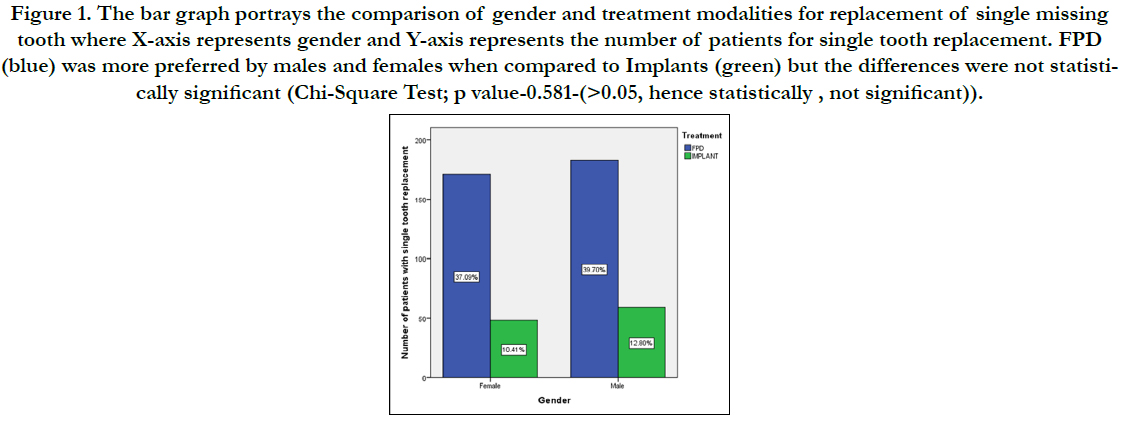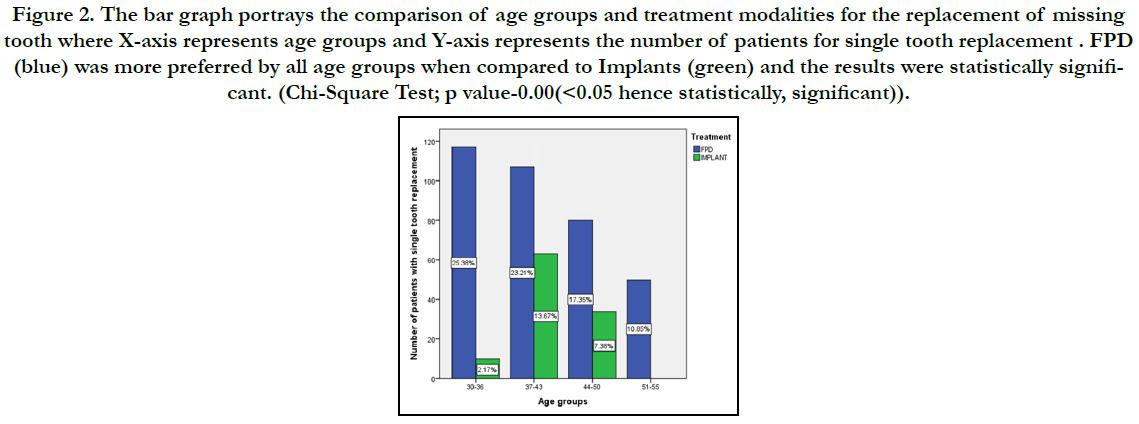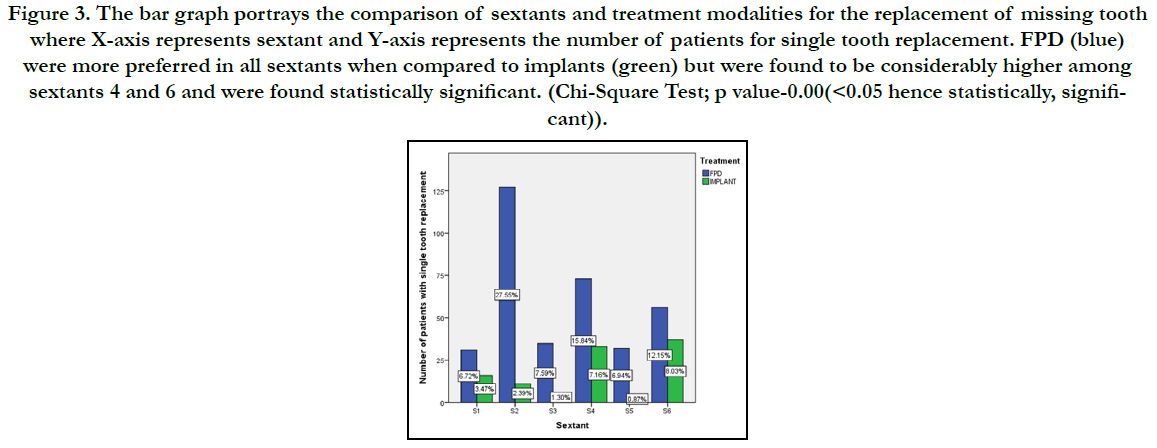Single Tooth Replacement in Middle Aged Adults - A Retrospective Study
Gokul Gunasekaran1, V. Ashok2*, Srirenga Lakshmi3
1 Saveetha Dental College and Hospitals, Saveetha Institute of Medical and Technical Sciences, Saveetha University, Chennai, India.
2 Professor and Head, Department of Prosthodontics, Saveetha Dental College and Hospitals, Saveetha Institute of Medical and Technical Sciences, Saveetha University, Chennai, 600077, India.
3 Senior Lecturer, Department of Orthodontics, Saveetha Dental College and Hospitals, Saveetha Institute of Medical and Technical Sciences, Saveetha University, Chennai, 600077, India.
*Corresponding Author
V. Ashok,
Professor and Head, Department of Prosthodontics, Saveetha Dental College and Hospitals, Saveetha Institute of Medical and Technical Sciences, Saveetha University, Chennai,
600077, India.
E-mail: ashok@saveetha.com
Received: November 10, 2020; Accepted: December 15, 2020; Published: December 18, 2020
Citation: Gokul Gunasekaran, V. Ashok, Srirenga Lakshmi. Single Tooth Replacement in Middle Aged Adults - A Retrospective Study. Int J Dentistry Oral Sci. 2020;7(12):1271-1274. doi: dx.doi.org/10.19070/2377-8075-20000251
Copyright: V. Ashok©2020. This is an open-access article distributed under the terms of the Creative Commons Attribution License, which permits unrestricted use, distribution and reproduction in any medium, provided the original author and source are credited.
Abstract
The choice between several treatment options for replacing a single missing tooth is influenced by clinical, dentist- and patientimmanent factors. This study aimed to determine the prevalence of age distribution and gender of the patient choosing Fixed Partial Denture (FPD) or Implant for single tooth replacement. The study compares the different treatment modalities (FPD or implant) for single tooth replacement of 461 patients records by comparison of the age group, gender and type of replacement which was obtained from the dental records at the private hospital. The analysis of the data gave more numbers of patients choosing FPD for the replacement of anterior teeth and lower posteriors for implants. The final choice between FPD or implant depended on several factors which affected the decision making; among these is cost and patients' awareness of the different treatment options. FPD is more opted for anteriors among the study population. More awareness on other treatment options for single tooth replacement must be made based on importance and advantages.
2.Introduction
3.Material and Methods
4.Statistical Analysis
5.Results
6.Discussion
7.Conclusion
8.Refereces
Keywords
Middle Age; Prosthesis; Single Tooth; Treatment Options.
Introduction
Replacement of missing teeth has become one of the most important
esthetic and functional needs for patients visiting a dental
clinic. The types of treatment modalities available for replacing a
single missing tooth are removable partial denture, fixed partial
denture or dental implant. Each modality is a possible treatment
option and has its own advantages and disadvantages [1]. There
are several factors affecting the final treatment decision regarding
the replacement of a missing tooth, these factors are case dependent.
In many cases if more than one treatment option is possible,
the final replacement depends on the patient's decision or
economic status or influenced by the patient's gender, age, public
awareness and patient's knowledge. Therefore, it is important
to understand the patient's needs and demands to determine the
kind of treatment that ensures the patient is satisfied with the
dental service provided. In many cases the cost of the treatment
is considered as a major determinant and ahead of oral health status
and patient preference. Pain and dental phobia are considered
as important factors as well and they might affect the patient's
decision not to receive treatment at all [2, 3]. Accessibility which
highlights important differences between people like a particular
form of prosthetic treatment may be equally available to young
and old patients, but the latter may find that the effort needed to
seek out that treatment is just too great [4]. Treatment decisions
cannot be performed depending on the basis of clinical examination
or a dentist's opinion alone, but should be discussed in close
consultation with patients [5]. In clinical decision making, dentists
routinely choose between alternative treatments such as crown
vs. amalgam/composite buildup; root canal treatment vs. extraction;
fixed bridge vs. removable partial denture; and periodontal
treatment vs. extraction. A number of clinical and patient factors
can influence the dentist's choice of treatment in these situations.
However, little is known about their relative importance. To address this issue, a list of clinical (e.g., periodontal status and caries
rate) and patient (e.g., cost and patient preference) factors possibly
influencing the choice of treatment was developed for each
pair of services [6]. Decision making style was associated with
service provision [7]. The term 'need' is commonly used to describe
the amount of treatment that dentist's judge their patients
ought to have, whilst 'demand' refers to the treatment requested
by the patients themselves [8]. Most studies of prosthetic need
and demand showed that the former is larger than the latter [9].
Other factors like the dentists, their particular skills, their accessibility
to the public and the economic realities of the community
in which they practise can affect the decision in choosing the
treatment in addition to the attitudes of people towards different
forms of treatment. These attitudes are influenced by such matters
as education, personal finance, and cultural background [10].
Previously our team had conducted numerous clinical trials [11-
17] and lab studies [18-22] and in-vitro students [23-25] over the
past 5 years. Now we are focussing on epidemiological surveys.
The idea for this survey stemmed from the current interest in our
community.
Despite the widespread concern in health care literature with
patients' satisfaction, there has been no clear definition of that
theory or the systematic consideration of its determinants and
consequences. The replacement of a missing tooth by any of the
prosthesis modalities occupies a major portion of the average
restorative and prosthodontic practice. Treatment options keep
changing due to continuous development in the field of dentistry
[26, 27]. This study aimed to determine the prevalence of age
distribution and gender of the patient choosing Fixed Partial
Denture (FPD) or Implant for single tooth replacement among
middle aged adults in Chennai.
Materials And Methods
This retrospective study was conducted in a university setting.
Data chosen for evaluation were patients who reported to a private
hospital for dental treatment.The details of the patients were
obtained from analysis of 86,000 patients from June, 2019 to
March, 2020 from the outpatient record of patients visited for
dental treatment, for the purpose of preservation and efficient
analysis of the patients details including intraoral and extra oral
pictures and treatments being done, which is maintained in a
confidential manner. These serve as records for the retrospective
studies.The study was conducted after getting ethical approval
from the Institutional Ethical Committee (Ethical approval number:
SDC/SIHEC/2020/DIASDATA/0619-0320). To minimise
sampling bias all data were included. The inclusion criteria included
patients who required single missing tooth replacement
and between the age group 35-55. The exclusion criteria included
patients with multiple missing teeth, below 35 and above 55 years
of age. Data was downloaded from the outpatient records and
imported to Excel. Data which was not required were excluded
and an Excel tabulation was done. The Excel sheet was then imported
to SPSS and results were obtained in the form of graphs
and tables. The advantages of the study included easy accessibility
and availability of the required data and drawback was the
available data was not location specific and belonged to different
ethnicity.Independent variables that were included in the study -
age, gender, sextant. The dependent variable included treatment
modality. The correlation and association between the variables
were analysed and assessed using this test.
Results And Discussion
The study included 461 participants who had undergone prosthetic
replacementment. Of the participants 219 were females
and 242 were males. The highest number of FPDs (117) were
inserted in the 30-36 age group while the highest number of implants(
63) were placed in the 37-43 age group.FPDs were preferably
placed in sextant 2 while implants were placed in sextant 4/
sextant 6. From Figure 1, FPDs were more preferred by males
and females when compared to implants. However, it was not
statistically significant. (Chi-square test; p=0.581- not significant).
From Figure 2, FPDs were more preferred by all age groups when
compared to implants but were found to be considerably higher
among 37-43 and 44-50 age groups.It was statistically significant.
(Chi-square test; p=0.00- highly significant). From Figure 3, FPDs
were more preferred by all sextants when compared to implants
but were found to be considerably higher among sextants 4 and
6. It was statistically significant. (Chi-square test; p=0.00- highly
significant).
The study helps to find the number of patients undergoing implants
and FPD. The study helps to find the number of patients
undergoing implants and FPD for single tooth replacement .
Another Study reported that dental implants can provide various
clinical and quality of life advantages compared to FPDs and implants
but it is more expensive when compared to other single tooth replacement modalities [28]. A reason for FPDs to be chosen
by patients instead of implants may be due to higher number
of visits and time period when compared to implants [29].
Figure 1. This bar chart shows the answer for the question - How satisfied are you with the ability to chew hard foods? X axis shows the answers with the options of For nothing or Little or Enough or Very or Totally and Y axis shows the frequency of each answer. Most common answer - For nothing (32%), while Very (24%) being the second most common answer, followed by Enough (18%), Little (14%) and Totally (12%).
Figure 2. This bar chart shows the answer for the question - How satisfied are you with the ability to chew soft foods? X axis shows the answers with the options of For nothing or Little or Enough or Very or Totally and Y axis shows the frequency of each answer. Most common answer - Little (26%), while Totally (24%) being the second most common answer, followed by For nothing (22%), Enough (18%) and Very (10%).
Figure 3. This bar chart shows the answer for the question - How satisfied are you with the retention of your denture? X axis shows the answers with the options of For nothing or Little or Enough or Very or Totally and Y axis shows the frequency of each answer. Most common answer - For nothing (28%), while Very (20%) and Little (20%) being the second most common answer, followed by Enough (16%), and Totally (16%).
The majority number of patients who chose single tooth replacement were males and FPDs were the most preferred treatment of choice.Rarely does a patient desire or accept a removable partial prosthesis as a substitute for a single missing tooth especially anterior tooth [30]. Another study stated that the cost was an important factor for choosing the preferred replacement modality especially for implant replacement [31]. Patients as well as dentists preferences regarding treatment options depend on several factors such as rejection to surgical procedures, treatment duration, cost, conditions of adjacent teeth or dental phobia. For a true economic evaluation, cost and benefits of different therapies are usually compared. The clinical outcome (benefit) in this study was 'single-tooth replacement. Additional research is needed to assess lifetime costs that include initial and maintenance costs, and future replacement costs associated with various alternatives. Besides, most of the reported studies compared FPD cost with other modalities [32]. Many factors must be considered when choosing between different treatment options for the replacement of a single-tooth, often the bias of the dentist plays a role rather than objective appraisal of the treatment options.Patient awareness of the advantages and disadvantages of different treatment modalities is very important for decision making, therefore there are many factors that make single-tooth replacement one of the most challenging restorations in dentistry.
Conclusion
Within the limitations of the study, it was found that FPD was
preferred among the middle aged adults when compared to implants
for single tooth replacement. The preferences for FPD
and Implants were found to be slightly higher among males when
compared to females. Most of the patients preferred FPD in the
anterior teeth region and implants in the posterior teeth region.
Therefore, more awareness and knowledge on other advanced
treatment modalities and its benefits must be made known to patients
prior to any prosthetic rehabilitation.
Acknowledgement
The authors thank Saveetha Dental College for constant support in providing the data for analysis.
References
- Christensen GJ. Elective vs. mandatory dentistry. J Am Dent Assoc. 2000 Oct;131(10):1496-8. PMID: 11042991.
- Shillingburg HT, Hobo S, Whitsett LD, Jacobi R, Brackett SE. Fundamentals of fixed prosthodontics. Quintessence Publishing Company; 1997 Jan.
- Kvale G, Berggren U, Milgrom P. Dental fear in adults: a meta-analysis of behavioral interventions. Community Dent Oral Epidemiol. 2004 Aug;32(4):250-64. PMID: 15239776.
- Bianco G, Di Raimondo R, Luongo G, Paoleschi C, Piccoli P, Piccoli C, Rangert B. Osseointegrated implant for single-tooth replacement: a retrospective multicenter study on routine use in private practice. Clin Implant Dent Relat Res. 2000;2(3):152-8. PMID: 11359260.
- Maizels J, Maizels A, Sheiham A. Sociodental approach to the identification of dental treatment-need groups. Community Dent Oral Epidemiol. 1993 Dec;21(6):340-6. PMID: 8306610.
- Grembowski D, Milgrom P, Fiset L. Factors influencing dental decision making. J Public Health Dent. 1988 Summer;48(3):159-67. PMID: 3045303.
- Brennan DS, Spencer AJ. Factors influencing choice of dental treatment by private general practitioners. Int J Behav Med. 2002;9(2):94-110. PMID: 12174535.
- Öwall B, Käyser AF, Carlsson GE. Prosthodontics: principles and management strategies. Mosby; 1996.
- Wiens JP, Priebe JW, Curtis DA, editors. Journal of Prosthodontics on Complete and Removable Dentures. John Wiley & Sons; 2018 Feb 12.
- Davenport JC, Davenport JC, Basker RM, Heath JR. A clinical guide to removable partial denture design. British Dental Association; 2000.
- Jyothi S, Robin PK, Ganapathy D. Periodontal health status of three different groups wearing temporary partial denture. Research Journal of Pharmacy and Technology. 2017 Dec 1;10(12):4339-42.
- Jain AR, Nallaswamy D, Ariga P, Ganapathy DM. Determination of correlation of width of maxillary anterior teeth using extraoral and intraoral factors in Indian population: A systematic review. World J Dent. 2018 Jan;9:68-75.
- Duraisamy R, Krishnan CS, Ramasubramanian H, Sampathkumar J, Mariappan S, Navarasampatti Sivaprakasam A. Compatibility of Nonoriginal Abutments With Implants: Evaluation of Microgap at the Implant-Abutment Interface, With Original and Nonoriginal Abutments. Implant Dent. 2019 Jun;28(3):289-295. PMID: 31124826.
- Selvan SR, Ganapathy D. Efficacy of fifth generation cephalosporins against methicillin-resistant Staphylococcus aureus-A review. Research Journal of Pharmacy and Technology. 2016 Oct 28;9(10):1815-8.
- Ganapathy D, Sathyamoorthy A, Ranganathan H, Murthykumar K. Effect of Resin Bonded Luting Agents Influencing Marginal Discrepancy in All Ceramic Complete Veneer Crowns. J Clin Diagn Res. 2016 Dec;10(12):ZC67- ZC70. PMID: 28209008.
- Subasree S, Murthykumar K. Effect of aloe vera in oral health-A review. Research Journal of Pharmacy and Technology. 2016 May 1;9(5):609.
- Ranganathan H, Ganapathy DM, Jain AR. Cervical and Incisal Marginal Discrepancy in Ceramic Laminate Veneering Materials: A SEM Analysis. Contemp Clin Dent. 2017 Apr-Jun;8(2):272-278. PMID: 28839415.
- Vijayalakshmi B, Ganapathy D. Medical management of cellulitis. Research Journal of Pharmacy and Technology. 2016 Nov 28;9(11):2067-70.
- Ganapathy DM, Kannan A, Venugopalan S. Effect of coated surfaces influencing screw loosening in implants: A systematic review and meta-analysis. World Journal of Dentistry. 2017 Nov; 8(6): 496-502.
- Ashok V, Suvitha S. Awareness of all ceramic restoration in rural population. Research Journal of Pharmacy and Technology. 2016 Oct 28;9(10):1691-3.
- Ashok V, Nallaswamy D, Benazir Begum S, Nesappan T. Lip Bumper Prosthesis for an Acromegaly Patient: A Clinical Report. J Indian Prosthodont Soc. 2014 Dec;14(Suppl 1):279-82. PMID: 26199531.
- Venugopalan S, Ariga P, Aggarwal P, Viswanath A. Magnetically retained silicone facial prosthesis. Niger J Clin Pract. 2014 Mar-Apr;17(2):260-4. PMID: 24553044.
- Kannan A, Venugopalan S. A systematic review on the effect of use of impregnated retraction cords on gingiva. Research Journal of Pharmacy and Technology. 2018 May 30;11(5):2121-6. h
- Basha FY, Ganapathy D, Venugopalan S. Oral hygiene status among pregnant women. Research Journal of Pharmacy and Technology. 2018 Jul 31;11(7):3099-102.
- Ajay R, Suma K, Ali SA, Kumar Sivakumar JS, Rakshagan V, Devaki V, Divya K. Effect of Surface Modifications on the Retention of Cement-retained Implant Crowns under Fatigue Loads: An In vitro Study. J Pharm Bioallied Sci. 2017 Nov;9(Suppl 1):S154-S160. PMID: 29284956.
- Garcia LT, Cronin RJ Jr. The partially edentulous patient: fixed prosthodontics or implant treatment options. Tex Dent J. 2003 Dec;120(12):1148-56. PMID: 14740394.
- Salinas TJ, Block MS, Sadan A. Fixed partial denture or single-tooth implant restoration? Statistical considerations for sequencing and treatment. J Oral Maxillofac Surg. 2004 Sep;62(9 Suppl 2):2-16. PMID: 15332176.
- Christensen GJ. Three-unit fixed prostheses versus implant-supported single crowns. J Am Dent Assoc. 2008 Feb;139(2):191-4. PMID: 18245688.
- Brägger U, Krenander P, Lang NP. Economic aspects of single-tooth replacement. Clin Oral Implants Res. 2005 Jun;16(3):335-41. PMID: 15877754.
- Walmsley D. Book reviewFundamentals of Fixed Prosthodontics 4th edn. By Herbert T. Shillingburg HT and colleagues. London: Quintessence Books, 2012. Dental Update. 2012; 592–592.
- Tepper G, Haas R, Mailath G, Teller C, Zechner W, Watzak G, et al. Representative marketing-oriented study on implants in the Austrian population. I. Level of information, sources of information and need for patient information. Clin Oral Implants Res. 2003 Oct;14(5):621-33. PMID: 12969367.
- Al-Quran FA, Al-Ghalayini RF, Al-Zu'bi BN. Single-tooth replacement: factors affecting different prosthetic treatment modalities. BMC Oral Health. 2011 Dec 21;11:34. PMID: 22188872.











